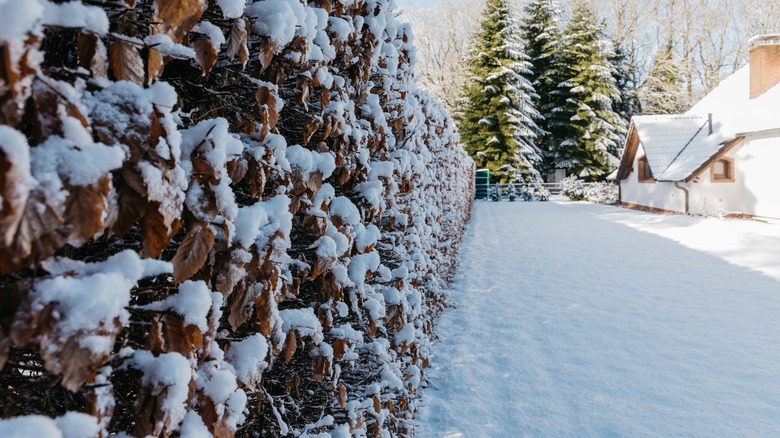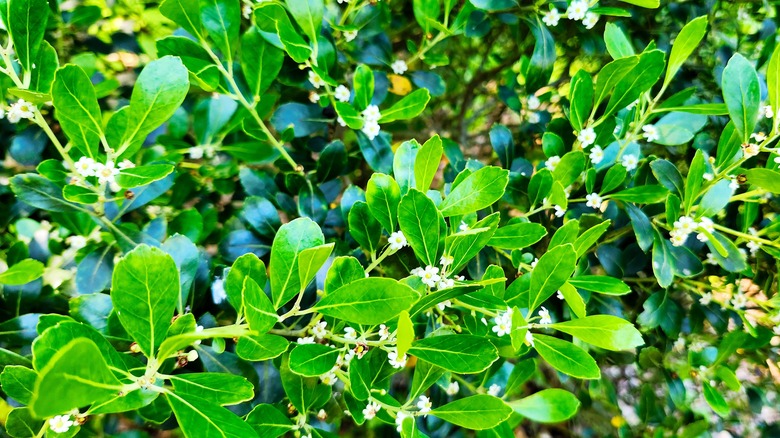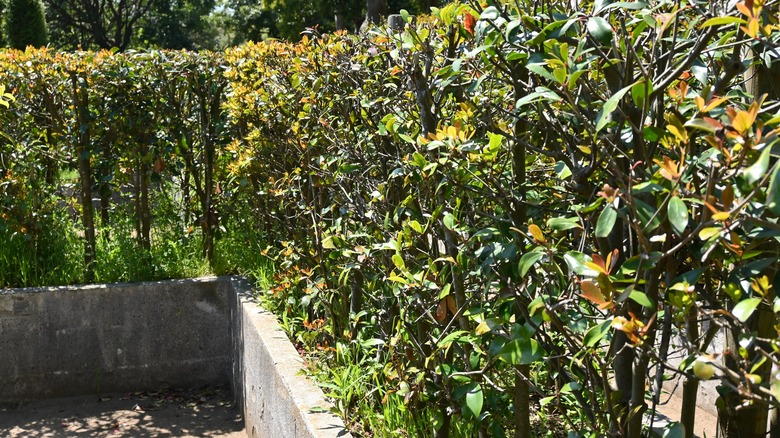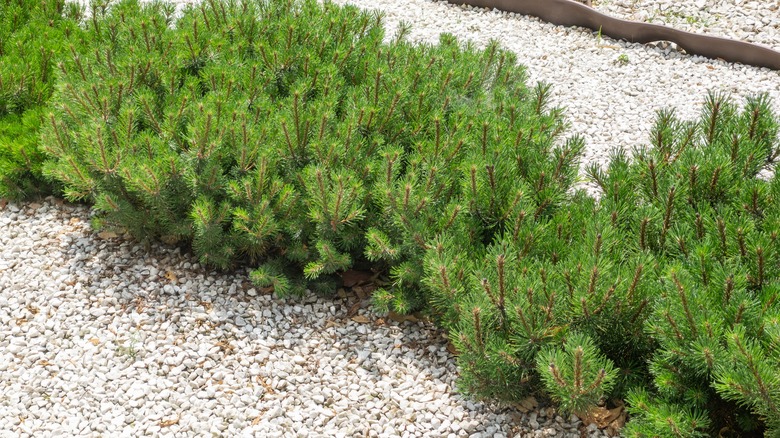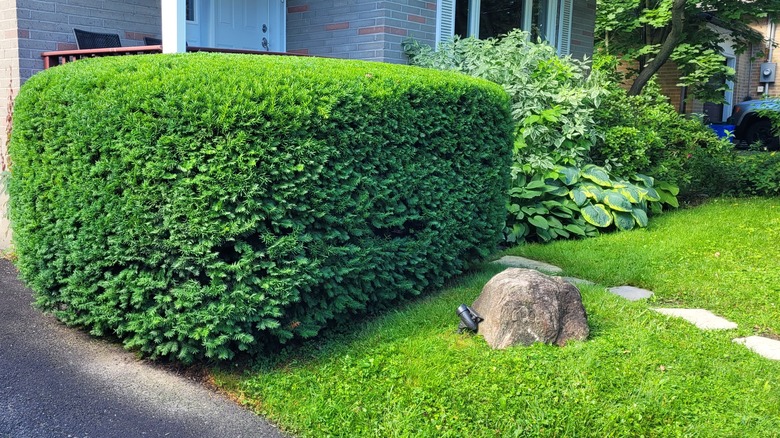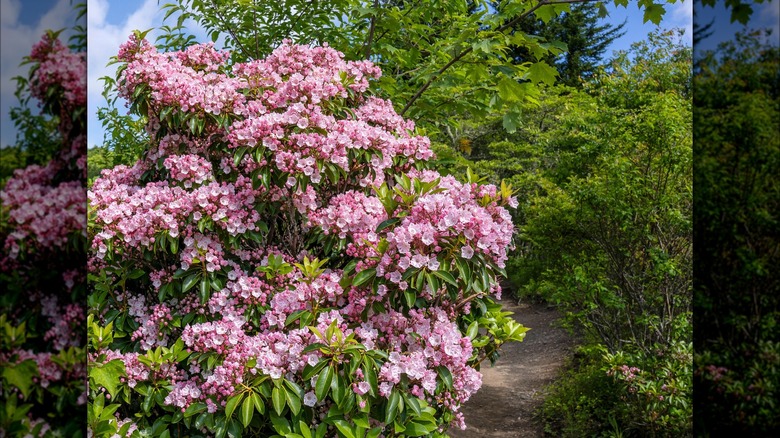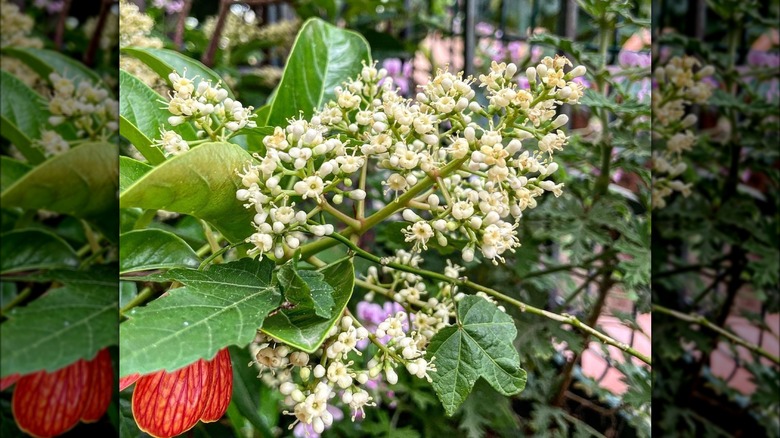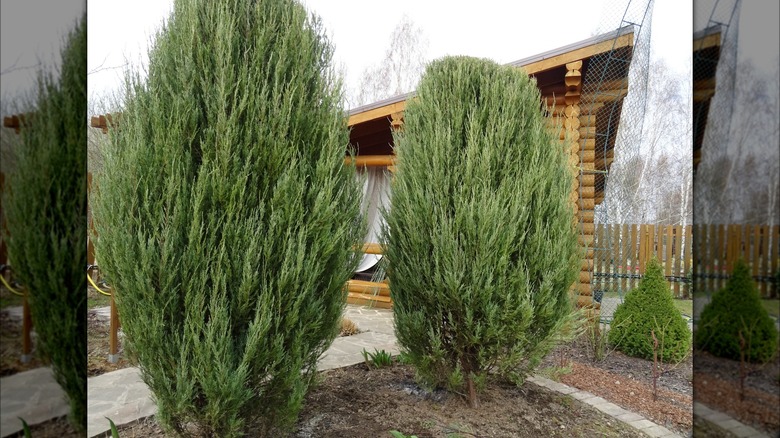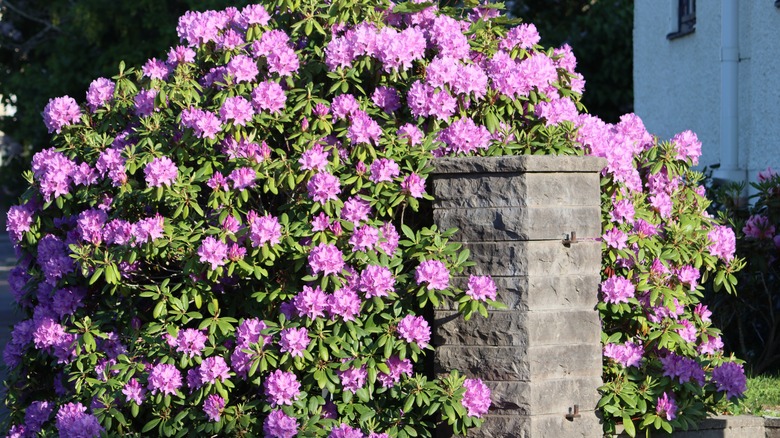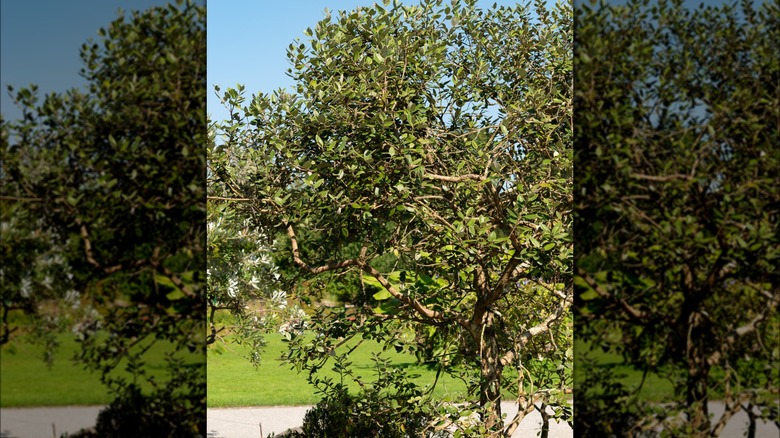9 Evergreen Hedges And Shrubs That Provide Privacy In Winter
While erecting fancy privacy screens or white picket fences to create a semblance of seclusion on your property is nice, they aren't as warm or graceful as living hedges. However, to ensure winter doesn't leave bare chinks in your yard by stripping down or tarnishing deciduous greens, you must grow evergreen shrubs and trees. Besides privacy, security, and lifting your winter aesthetic with their dense, green foliage, they help reduce pedestrian and neighborly noise. Assuming they aren't fast growers, and thus weak-limbed, they may also double up as windbreaks. Opting for flowering and fruiting evergreen hedges might also help out birds, pollinators, or mammals looking for quick meals, hunting vantage, and shelter.
Although it's tempting to plant rows of single specimens for a formal look, it makes your privacy hedge susceptible to pests and diseases. Leyland cypress or boxwood hedge planters can probably attest to that, considering how efficiently bagworms and blight take over, compelling their removal. So, it's ideal you plant mixed rows of evergreen shrubs (like mountain laurel, yew, and inkberry) so that their attractors (pollinators) can keep each other's detractors (pests) in check. This way, you can also enjoy a different pop of color year-round. Before planting, ascertain whether the selected variety's height adheres to your local community's or HOA's guidelines and is appropriate for your lot's size. Here are nine of the best evergreen hedges and shrubs for privacy in winter.
Inkberry
Inkberry (Ilex glabra) is a bird- and butterfly-friendly, deer-resistant shrub to use to landscape your yard for winter privacy. It's a slow grower, maturing to heights and spreads of under 8 feet, although more compact cultivars like 'Shamrock' are available. Inkberry shrubs sprout spineless, glossy, smooth green blades that remain attractive through zone 4 winters. However, they may grow unsightly if the negative temperatures persist for extended durations. Regular spring pruning is essential to prevent the shrubs from growing scraggly at their bases. They tolerate heavy and wet soils, provided they're acidic. Remove their root suckers to keep their sprawl contained.
Japanese ternstroemia
Consider Japanese ternstroemia (Ternstroemia gymnanthera) to replace your disease-riddled Leyland cypress or photinia hedges, as it resists foliar diseases. It extends over 6-feet-wide (making it appropriate in narrow spaces like side yards), and nearly twice as tall. It's non-invasive and is hardy in zones 7 to 10. Japanese ternstroemia's leathery, spoon-shaped foliage is maroon-tinged in the spring, topped by fragrant, white flowers. Through the summer, it grows dark green, assuming red-bronze tones in the winter chill. While it can stand full sun, leaf scorch may become imminent. So, it's best sited in moderately shaded, acidic locations.
Mugo pine
Also known as Swiss mountain pine, mugo pine (Pinus mugo) is a needled evergreen species from Europe. Since its varieties and cultivars are available in multiple forms and heights, it's liberally used in home landscapes for screening. Its tolerance against urban pollution especially helps. In hardiness zones 2 through 7, mugo pines establish broad mounds of short, spiraled green needles, coveted by moths. The needles grow bronze in the winter and can persist for nearly five years, sheltering a myriad of birds and small mammals. This plant will thrive in sandy soil, provided it drains adequately and is full-sun exposed.
Yew
Armed with different varieties native to the east or the west in the U.S., yew shrubs (Taxus spp.) will please native plant enthusiasts. Luckily, they hold up well against pruning, inspiring unique hedging designs. As such, you wouldn't be hard-pressed to find cultivars in globular, fastigiate, drooping, or pyramidal forms either. Yews showcase glossy green needles year-round, often littered with bird-adored red fruits in the fall. To enjoy the latter, you must plant a fertilizing male species. While they're considered hardy in zones 4 through 8, their foliage can weaken in zone 4's winter. If you have children or pets in your home, you may want to rethink planting this species as it is considered poisonous to humans and animals.
Mountain laurel
Connecticut's state flower, mountain laurel (Kalmia latifolia) is another broadleaf evergreen shrub that can be massed into a deer-resistant, winter privacy hedge. It has leathery green leaves with pale undersides (like rhododendrons) that may age into yellows. It's also highly sought after by hummingbirds and butterflies for its white, pink, or lavender flowers. Depending on the variety, mountain laurels can grow around 15 feet tall and half as wide. They're ideal if your property remains shaded for the most part in growth zones 4 through 9. Trim the branches immediately after flowering to encourage a fuller shape.
'Chindo' viburnum
If patience isn't your strong suit, consider growing 'Chindo' viburnum (Viburnum awabuki 'Chindo'). Its rapid growth rate ensures your informal hedge will be nearly 8-feet-wide and twice as tall in a few years, without missing out on windbreaking benefits. Chindo is striking with its pyramidally-arranged, lustrous, red-toned green leaves. It attracts pollinators and songbirds with aromatic white petals and purplish-red berries. The best part, though? These evergreen viburnum bushes adapt to most site conditions, from acidic to alkaline soils, sandy to clay textures, and full sun to partial shade. They're drought-tolerant after establishment in zones 7b to 9b.
'Blue Arrow' juniper
In locations graced by copious sunlight, plant 'Blue Arrow' juniper (Juniperus scopulorum 'Blue Arrow') and relish its formal, Mediterranean likeness. You may even use it to fill out the irregularly shaped, exposed spots in your existing hedges, as it stands only 2-feet-wide. 'Blue Arrow' adds a dramatic flair (and birds) with its blue-green, needled foliage. Even better, it brings in festive cheer by producing silvery blue berries when winter food is scarce. Barring wet soils, it holds well in every other substrate, regardless of the alkalinity or compaction. It's herbivory and salt-tolerant.
Catawba rhododendron
Use catawba rhododendron (Rhododendron catawbiense), or mountain rosebay, to add flowery touches and wildlife value to your winter privacy. These blueberry cousins pack their leathery leaves in 10-foot-wide thickets that are similarly tall. Hummingbirds, native bees, and butterflies seek their spring-blooming, pinkish-lavender flowers. They withstand anything between full sun and deep shade in hardiness zones 4 through 8. Afternoon shade is appreciated, as is protection from winds. Their soils should be acidic and nutrient-rich. Since they sprout surface-level roots, mulching is necessary to prevent desiccation. Fair warning if you have children or pets however, as this shrub is highly poisonous.
Pineapple guava
Hailing from South America, pineapple guava (Acca sellowiana) is a non-invasive, evergreen shrub that brings a tropical touch to any yard. It drapes the winterscape with gristly, egg-like, silvery-green foliage. Other seasons are marked by the presence of purple-mottled, fleshy white blooms and edible blue-gray fruits that songbirds adore. Deer-resistant, pineapple guava will thrive in both sand and clay soils, provided they drain well. A minimum of two hours of daily direct sunlight will have them reach 10 feet in height; though in the upper ranges of zone 8, they'll likely top out at 5 feet.
